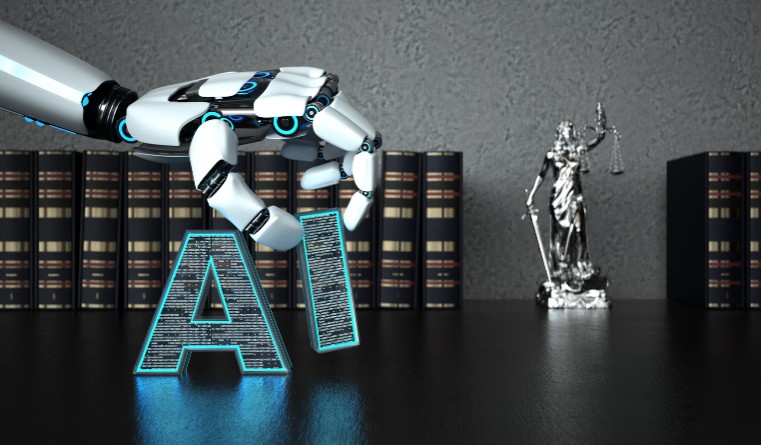From a past of typing pools and stenographers to a future of powerful AI legal analysts, artificial intelligence is changing the way lawyers do business. Baruch Gottesman and Eunice Yan examine what has changed – and what will continue to change as lawyers increasingly turn to AI assistance.
Let’s walk through the law office of the 1970s.
We push through the heavy mahogany doors to the building and are greeted by a receptionist, responsible for scheduling, directing phone calls and facilitating meetings. The receptionist then directs us through the typing pool, as we walk past a large group of stenographers transcribing, editing and finalizing documents for court submission. We may also step out of the way of couriers rushing between courts, delivering original papers for signature, serving as the bloodstream of the legal process.
We finally make it to the executive suite. We meet the partner, who sits with a coffee pot and a telephone – the only technology being used by old-school attorneys educated in the mid-20th century.
We notice that this looks nothing like the modern business environment. Technology has entirely replaced several distinct occupational roles. Even though the core legal function hasn't changed, typing pools have vanished, email and digital communication have superseded paper and phone calls, and a laptop with Wi-Fi now suffices for most legal work in 2025.
The revolution was streamed and is now taken for granted.
Artificial intelligence stands poised to transform legal practice and business operations in the 2020s and 2030s as profoundly as the internet did in the early 2000s.
The AI revolution
AI – even in its current embryonic form – is poised to entirely change the legal landscape, especially in the world of AI. This article will review current and short-term changes that are “here” and coming this year; and then will speculate about some mid-term developments to anticipate. We will conclude with some thoughts for the practitioner and for those involved in cross-border business on how to future-proof their operations.
Current capabilities
Ghibli-style cartoons and video memes circulate and make the news. But that hides the current capabilities of AI that are not even begun to be exploited by legal professionals in the intellectual property fields.
First: With the right tools in the hands of a capable coder and knowledgeable lawyer, data in all formats, all languages, all platforms and all environments can be aligned.
Let’s give a concrete example. An American lawyer represents defendants on Schedule A mass intellectual property infringement cases in U.S. courts. In a typical case, the legal papers are filed in PDF format, in the English language, through the court filing system (PACER). The sales information at issue is maintained in a tagged data maintained in CSV, json and other coding formats. The client information is in Chinese and provided through hand-filled forms, WeChats, and other means.
The intellectual property practitioner needs to review and understand the information from these different sources. In the past, this would require heavy involvement of a translator and Chinese connections to explain the legal proceedings and to understand the client’s concerns. A manual review of the data would be required and often the re-entry of the sales data, and continual monitoring of the case, information from the client and progress of discovery.
With today’s tools, all of this can be automated. Regardless of whether the information is inputted in text, audio or video; and regardless of the language (English, Mandarin or CSV data) it can be taken in, aligned, and put to its proper use. As a practical matter, the IP practitioner can focus on client development and outreach, negotiations with opposing counsel, and the substance of lawyering. Anything that can be converted into data can be done autonomously and with full transparency in every language: ready to be deployed in English and Chinese; to the client, the court and counsel; and in any and every format.
It would be absurd for a lawyer to remain wedded to the typing pool and refuse to use modern word processing applications. Going forward, it will be absurd for a lawyer to remain wedded to the manual review, translation, and adaptation of anything that can be converted into data.
To get to this point requires a good understanding of code (which can be heavily assisted with AI) and the capabilities and limits of AI tools. But that investment is better made now than later, and there are teams ready to onboard modern lawyers to the AI present.
Second: AI is at the start of being able to organize and help create clear writing for legal papers and arguments.
Now, one needs to be very careful here. AI is not ready to engage in legal research or really serve as a capable tool in the legal drafting process. This mostly comes down to “hallucinations”. These dangerous hallucinations come in two flavours: one obvious and one even more insidious.
The obvious pitfall is when AI hallucinates non-existent legal cases. In a recent example, Coomer v. Lindell, et al., Case No. 22-cv-01129, 2025 U.S. Dist LEXIS 77555 (United States District Court for the District of Colorado April 23, 2025), a lawyer faced potential sanctions for submitting legal filings with 30 defective cases that included “misquotes of cited cases; misrepresentation of principles of law associated with the cited cases, including discussions of legal principles that simply do not appear within such decisions; misstatements regarding whether case law original from binding authority . . . misattribution of case law to this District; and most egregiously, citation of cases of cases that do not exist.” Coomer, 2025 U.S. Dist. LEXIS 77555 at *4.
This phenomenon is increasing and actually shows how the use of AI for legal filings is – at this point – premature and potentially counterproductive. The widespread misuse of AI, including hallucinated references and citations, now imposes on lawyers who rely on Associates or researchers the obligation to review every citation personally. This actually imposes more work than the “old days” when one could assume that the citations and principles of law provided are technically accurate.
There is another species of hallucination even more insidious. Large language models (LLMs) have been trained to sound confident. Unless carefully prompted, AI chatbots do not suggest ideas or point the researcher in the right direction. When asked about legal issues, AIs will confidently state the law, even when it is not correct. Even when prompted to limit their analysis to a particular rule or a specific jurisdiction or rule, LLMs will output text that sounds good but is often wrong and indeed weaker because of the limited universe of training material under that rule and in that jurisdiction. The misinformation spat out by the AI can send the researcher down a blind alley looking for rules and readings that do not exist and are not true.
What AI can do is clean up language, point the lawyer in the direction of proper areas of inquiry (being careful to ignore any conclusions suggested by AI), and cleanly organize information that has already been confirmed to be an accurate statement of the law. Those tools can and should be used. But that use case is limited for now.
While some folks are working on solutions to the hallucinations problem (this writer is part of a startup that’s developing long-term solutions) for now, it is sufficiently problematic to limit the use of AI in legal drafting to organization and tone, but not for original research or to find citations for a principle.
Third: Communications, especially cross-border, is becoming much clearer and seamless. While cultural gaps will remain, the quality level of AI adaptation of spoken and written Mandarin into English and vice-versa has become close to that of professional translators. It not only allows flexibility to engage in discussions with clients and negotiations with parties on your own schedule, it frees up the need to “dumb things down” when communicating cross-border.
Rather than generally describe a legal filing to a client overseas, AI can translate documents at near-expert level and in a matter of minutes, not hours. Similarly, documents in Mandarin or other foreign languages can be adapted into English in minutes, rather than hours – with details explored later.
What the future holds
The above describes the current state of AI in the American intellectual property rights legal practice. Now we’ll discuss what we may see in the next few years as AI rapidly develops.
First: AI is developing to the point where it can be used for actual legal research and writing. As discussed above, current LLMs cannot distinguish accurate statements of law from statements that are statistically consistent with the style of language in the training data, but entirely wrong. Bespoke LLMs that are attuned to distinguish the applicable law in the jurisdiction, the current state of the law as opposed to general statements and historical rules and even more narrowly tailored assessment of how a particular judge would assess an argument based on their history. Those are not here, but they are coming in the next decade.
Second: In the intellectual property field, which is often about the review of massive amounts of data, AI will get to the point where it can competently assess infringement risk by manufacturers in advance, by identifying alleged infringement, and by streamlining enforcement. AI will increasingly allow mass cases to be resolved quickly and fairly with relatively little “human” intervention on particular cases.
Conclusion
Let us step back into that 1970s law office, but now it’s 2030.
The mahogany doors remain, but as you enter, a digital concierge – powered by advanced AI – greets us by name, knows who we are, why we are there and has everything scheduled and prepared. There are no typing pools, no paralegals buried in document review and surprisingly few attorneys.
The legal practitioners you do see devote their time to strategic discussions with clients and meetings with the coders. They serve more as consultants as they work alongside AI tools to analyze legal issues in real-time, generate document drafts, predict judicial outcomes with remarkable accuracy and translate complex legal concepts into plain language for clients.
Ironically, it is a world where the practice of law has returned to the pre-modern era, where it is about its most uniquely human elements – empathy, moral reasoning, and persuasive advocacy – while AI handles the technical material. That is the promise of artificial intelligence, and it’s a world that’s coming whether we are ready for it or not.










